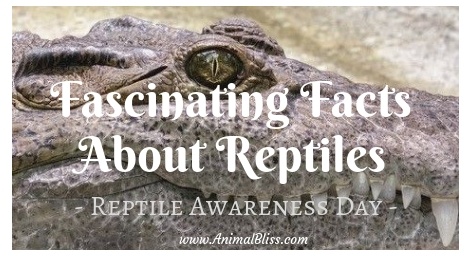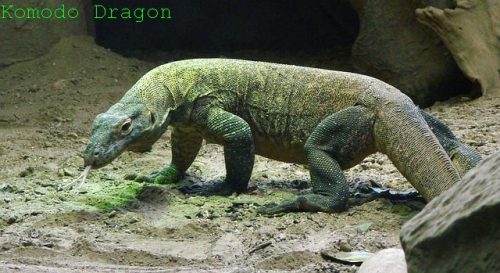Ten Fascinating Facts About Reptiles
ExoticDirect pet insurance has collected ten of the most fascinating facts about reptiles for Reptile Awareness Day on October 21st.

1. There are four main reptile groups.
- Crocodilians, which includes alligators and crocodiles;
- Squamates, which includes lizards and snakes;
- Tuatara, which look like lizards but differ in their bone structure;
- Turtles.
Turtles and Crocodilians have remained largely unchanged since they appeared around 200 million years ago. Squamates are the most diverse group, containing around seven and a half thousand different species.
You might remember the famous scene from Planet Earth in which the baby iguana is chased by snakes, perhaps one of the tensest television scenes of all time. This iguana, being a lizard, belongs to the Squamate group.
2. Reptiles and birds are related.
Some reptiles, like crocodiles, are more closely related to birds than they are to other lizards.
For this reason, some scientists have started to consider birds a part of the Reptilia class, one of the stages of the taxonomic rank that groups evolutionarily similar animals together.
The reason for this is because birds, lizards, snakes, turtles, and crocodiles all descended from a common ancestor that lived around 300 million years ago.
Reptiles evolved from amphibians, being some of the first animals to live on land rather than in water.
For this reason, reptiles are sometimes considered the evolutionary step between these amphibians and more recent animals, including dinosaurs (okay, not that recent), mammals, and birds.
3. Reptiles’ skin developed through evolution.
Reptiles scaly skin evolved as a layer of protection, meaning these animals could finally move away from bodies of water and live on the land without risk of drying out.
For the snake, which is entirely covered in scales, the skin gives protection, helps it move, and also functions as camouflage.
Reptiles either shed their skin in flakes or all at once as snakes do. This shedding of the old, worn out skin means the reptile has a nice new set to live in. It also helps to remove parasites which may harm the reptile.
Some geckos even eat their own shed skin.
4. Reptiles are cold-blooded.
Or, in scientific terms, ectothermic, which means that they rely on the world to keep them warm, rather than having internal ways to regulate their body temperature.
Therefore, reptiles, like crocodiles and snakes, relax in the sun during the day to warm themselves up and reenergize. Then, in the evenings, they become sluggish, having no sun to keep them powered up.
This might sound like an inefficient way to live, but it means they’re able to eat significantly less than other animals like birds and mammals; it does, however, mean they’re unable to remain active at night.
5. Reptiles’ hearts are not like ours.
Most reptiles have three-chambered hearts, which differs from the human’s four chambers, which does pose some health benefits: reptiles are usually better at enduring more significant changes in heart rate and blood pressure.
Crocodilians, however, do possess four-chambered hearts. Their anatomy is still pretty different from a human’s, though. (But you could have told that just by looking at them.)
6. Some reptiles change sex based on temperature.
Almost all reptiles lay eggs which have leathery-feeling shells. This shell helps to protect the eggs while preventing them from drying out.
Some reptiles have temperature-dependent sex determination, meaning the sex of the reptile is determined by how hot or cold the egg is incubated. This is exhibited most commonly in turtles and crocodiles but is also true of some lizards too.
And snakes? Scientists don’t know yet. Come on, guys, get it together.
7. Unfortunately, reptiles can suffer from some pretty bad illnesses.
Royal Pythons, for example, can suffer from anorexia. Some have been known to not eat for up to eleven weeks which can be due to health problems that cause the python to lose his or her appetite. Someone has even made a claim to ExoticDirect for this for £473.
Bearded Dragons can suffer from a metabolic bone disease. This can be a pretty serious condition, and ExoticDirect has paid out £396 for this before.
Finally, Tegus can suffer, embarrassingly, from constipation – not a very comfortable illness for a reptile (or a human, for that matter). ExoticDirect paid out £714 to a customer for this illness in 2018.

8. Reptiles can be pretty dangerous unless you’re in the UK.
The last recorded death from an Adder bite in England, for example, was in 1975. Saying that, of the roughly 3,400 snake species, 600 are venomous. Luckily, the Adder is the only poisonous species the UK has. (That is, lucky if you live in the UK.)
Then there is the Alligator Snapping Turtle, the bite of which has been known to take off fingers and limbs due to how strong the jaw is. The Komodo dragon, the largest living lizard species, growing to about three meters (almost 10 feet) long, is a quick mover and attacks on humans have been reported in both the wild and in captivity. According to some sources, crocodiles kill around 800 people per year.
Saltwater crocs, the largest of the crocodiles, have a powerful bite, exerting thousands of kilos of pressure per square inch when they bite down. But hey, Steve Irwin used to play with crocs all the time. (We still don’t recommend doing it.)
9. Dreaming of snakes …
Perhaps it’s because of an Indiana Jones fear-of-snakes style complex, or maybe from reading too many Harry Potter books, but surveys suggest that the animal people dream of most often is the snake.
According to dream websites, dreaming of snakes means you’re working through resolving an issue you have in your life, and can also be a sign of transformation, something taken from the snake’s ability to shed its skin. Whatever the truth of these analyses, you certainly wouldn’t want a snake in your bed.
10. A few world records
According to Our Planet, in 2017 the largest crocodile ever captured and put into captivity was – brace yourself – a whopping 6.17 meters (20 feet!) long, and it was suspected he ate two human beings. And in 2017, the Guinness Book of World Records website put the largest crocodile that ever lived as a Sarcosuchus Imperator, who was a petrifying 12 meters (39 feet) long. This writer is getting the shakes just thinking about it.
The longest snake, meanwhile, is 7.67 meters long (25 feet). Medusa, a reticulated python, is housed in Kansas City. She’s eaten a whole deer in one sitting before and weighs a hefty 158.8kg (350 lb) according to the Guinness Book of World Records in 2011. She is owned by Full Moon Productions in Kansas City.
The oldest tortoise, Adwaita, was estimated to be at least 150 years old according to the BBC in 2006, and some estimates even put his age at a stately 250 years.
Finally, the largest reptile zoo in the world is in South Dakota, USA, and houses 225 different species and subspecies (as of 2013).
So if this piece has inspired you to learn more about reptiles, head to Reptile Gardens just outside of Rapid City.
Own a reptile? ExoticDirect can insure reptiles including tortoises, birds, and both small and large mammals. If you’re a UK resident, why not get a quote?
By James Alston writing for ExoticDirect pet insurance.
Conclusion
We hope you have enjoyed these fascinating facts about reptiles for Reptile Awareness Day – October 21.
*** Please Share ***
Fascinating Facts About Reptiles - Reptile Awareness Day, October 21 #ReptileFacts Share on X![]()
MY QUESTION FOR YOU:
Did you learn something new from reading our fascinating facts about reptiles?
*** Leave your comment below. ***
(It’s just sexy!)

Peace
DISCLOSURE: Animal Bliss is a participant in the Amazon Services LLC Associates Program, an affiliate advertising program designed to provide a means for us to earn fees by linking to Amazon.com and affiliated sites.
(In other words, we’ll get a very small (teeny tiny) commission from purchases made through links on this website.)
So, go on … Don’t be shy!
Buy Something BIG and Expensive!
Thank you!
😀
[amazon_link asins=’0789493934,B00Y05PPVU,1426325266,1426214766,1426321023,0312499213′ template=’ProductCarousel’ store=’animblis-20′ marketplace=’US’ link_id=’1fb75b9d-d545-11e8-af28-270567ea0275′]
😀
- Mindful Travel With Your Dog This Holiday Season - December 23, 2019
- A-Z of Australia’s Endangered Wildlife - December 20, 2019
- Teaching Your Kids How to Walk the Dog Safely - December 2, 2019
